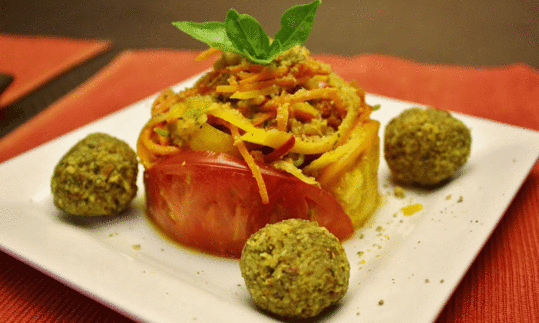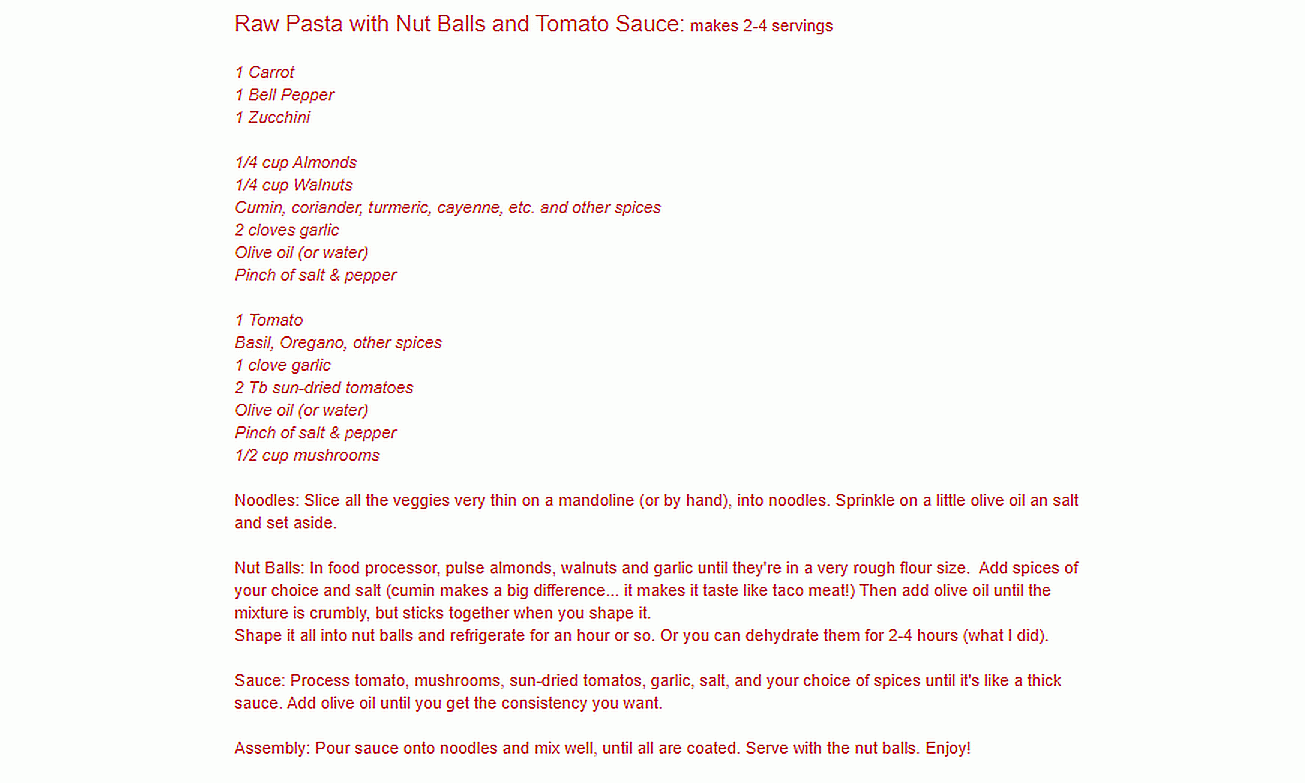Raw pasta with tomato sauce, nut balls and "parmesan cheese"
raw-vegan
Ingredients (for servings, )
Equipment
- food processor or shredder
- dehydrator or refrigerator
- mandoline
Type of preparation
- dehydrate
- chop or grind
- food preparation without heating
- blend
- cool
- season to taste
- remove the skin
- knead
Preparation
For the vegetable pasta
Using a mandolin (V-slicer, or by hand), cut the vegetables into very thin noodles. You can drizzle some olive oil and salt over them and set aside.The original recipe uses ¼ cup of almonds and shelled walnuts for 2 servings.
For the nut balls
In a food processor, pulse the almonds, walnuts and garlic until the consistency resembles coarse flour. Add spices of your choice and salt. Then add water (or olive oil) until the mixture is crumbly but still sticks together when you shape it.The original recipe doesn't specify the amount of spices, we just used a pinch here. Use the spices to your taste, for example cumin makes a big difference... it gives the nut balls the flavor of taco meat!
Now form nut balls from the mixture and place them in the fridge for about an hour. Alternatively, you can dehydrate the nut balls for 2-4 hours.
For the tomato sauce
Blend tomatoes, mushrooms, sun-dried tomatoes, garlic, salt and spices of your choice in a blender until you have a thick sauce. Add water (or olive oil) until you reach the desired consistency.The original recipe does not specify the amount of water/oil. Use it depending on the desired consistency. There are no further details about the spices either.
For 2 servings, the author uses ½ cup of sliced mushrooms, but we chose button mushrooms because of availability.
For the walnut "Parmesan cheese"
Process the walnuts into a coarse, floury mixture. Add the remaining ingredients until you have a "parmesan cheese" texture. Season to taste with spices such as pepper and curry powder.The original recipe calls for ¼ cup of shelled walnuts (about 25 grams) for 2 servings.
Arranging and Serving
Pour the tomato sauce over the vegetable pasta and mix well. Add the nut balls and sprinkle the walnut "parmesan cheese" on top.
|
Nutritional Information per person
Convert per 100g
|
2000 kcal | |
|---|---|---|
| Energy | 404 kcal | 20.2% |
| Fat/Lipids | 29 g | 41.3% |
| Saturated Fats | 2.8 g | 13.8% |
| Carbohydrates (inc.dietary fiber) | 30 g | 11.1% |
| Sugars | 15 g | 16.2% |
| Fiber | 11 g | 44.5% |
| Protein/Albumin | 15 g | 29.4% |
| Cooking Salt (Na:284.6 mg) | 723 mg | 30.1% |
| Essential micronutrients with the highest proportions | per person | 2000 kcal | |
|---|---|---|---|
| Vit | Vitamin B1 (Thiamine) | 2.0 mg | 178.0% |
| Vit | Vitamin C (ascorbic acid) | 138 mg | 173.0% |
| Fat | Linoleic acid; LA; 18:2 omega-6 | 12 g | 122.0% |
| Fat | Alpha-Linolenic acid; ALA; 18:3 omega-3 | 2.4 g | 119.0% |
| Min | Manganese, Mn | 2.0 mg | 98.0% |
| Min | Copper, Cu | 0.92 mg | 92.0% |
| Elem | Potassium, K | 1'346 mg | 67.0% |
| Vit | Vitamin B9, B11 (Folate, as the active form of folic acid) | 133 µg | 66.0% |
| Vit | Vitamin B6 (pyridoxine) | 0.84 mg | 60.0% |
| Vit | Vitamin E, as a-TEs | 7.2 mg | 60.0% |
Detailed Nutritional Information per Person for this Recipe
The majority of the nutritional information comes from the USDA (US Department of Agriculture). This means that the information for natural products is often incomplete or only given within broader categories, whereas in most cases products made from these have more complete information displayed.
If we take flaxseed, for example, the important essential amino acid ALA (omega-3) is only included in an overarching category whereas for flaxseed oil ALA is listed specifically. In time, we will be able to change this, but it will require a lot of work. An “i” appears behind ingredients that have been adjusted and an explanation appears when you hover over this symbol.
For Erb Muesli, the original calculations resulted in 48 % of the daily requirement of ALA — but with the correction, we see that the muesli actually covers >100 % of the necessary recommendation for the omega-3 fatty acid ALA. Our goal is to eventually be able to compare the nutritional value of our recipes with those that are used in conventional western lifestyles.
| Essential fatty acids | per person | 2000 kcal |
|---|---|---|
| Linoleic acid; LA; 18:2 omega-6 | 12 g | 122.0% |
| Alpha-Linolenic acid; ALA; 18:3 omega-3 | 2.4 g | 119.0% |
| Essential amino acids | per person | 2000 kcal |
|---|---|---|
| Tryptophan (Trp, W) | 0.13 g | 52.0% |
| Threonine (Thr, T, irreversibly transaminated) | 0.46 g | 49.0% |
| Isoleucine (Ile, I) | 0.45 g | 36.0% |
| Phenylalanine (Phe, F) | 0.56 g | 36.0% |
| Valin (Val, V) | 0.55 g | 34.0% |
| Leucine (Leu, L) | 0.80 g | 33.0% |
| Lysine (Lys, K, irreversibly transaminated) | 0.44 g | 23.0% |
| Methionine (Met, M) | 0.14 g | 15.0% |
| Vitamins | per person | 2000 kcal |
|---|---|---|
| Vitamin B1 (Thiamine) | 2.0 mg | 178.0% |
| Vitamin C (ascorbic acid) | 138 mg | 173.0% |
| Vitamin B9, B11 (Folate, as the active form of folic acid) | 133 µg | 66.0% |
| Vitamin B6 (pyridoxine) | 0.84 mg | 60.0% |
| Vitamin E, as a-TEs | 7.2 mg | 60.0% |
| Vitamin A, as RAE | 425 µg | 53.0% |
| Vitamin B2 (Riboflavin) | 0.72 mg | 51.0% |
| Vitamin K | 33 µg | 43.0% |
| Vitamin B7 (Biotin, ex vitamin H) | 20 µg | 39.0% |
| Vitamin B3 (Niacin) | 5.4 mg | 33.0% |
| Vitamin B5 (Pantothenic acid) | 1.6 mg | 26.0% |
| Vitamin D | 0.04 µg | 1.0% |
| Vitamin B12 (Cobalamin) | 0.01 µg | < 0.1% |
| Essential macroelements (macronutrients) | per person | 2000 kcal |
|---|---|---|
| Potassium, K | 1'346 mg | 67.0% |
| Phosphorus, P | 315 mg | 45.0% |
| Magnesium, Mg | 160 mg | 43.0% |
| Sodium, Na | 285 mg | 36.0% |
| Calcium, Ca | 152 mg | 19.0% |
| Essential trace elements (micronutrients) | per person | 2000 kcal |
|---|---|---|
| Manganese, Mn | 2.0 mg | 98.0% |
| Copper, Cu | 0.92 mg | 92.0% |
| Iron, Fe | 4.0 mg | 29.0% |
| Zinc, Zn | 2.4 mg | 24.0% |
| Selenium, Se | 4.9 µg | 9.0% |
| Iod, I (Jod, J) | 6.8 µg | 5.0% |
| Fluorine, F | 25 µg | 1.0% |
The raw pasta with tomato sauce, spicy nut balls and walnut "parmesan cheese" is the raw vegan version of spaghetti with meatballs.
Serving Size: The author states that this recipe makes enough for 2-4 servings. We find that it serves 2 people best. If you or your guests are hungry, you can adjust accordingly. Leftovers keep well in the fridge until the next day - however, the consistency may change.
Nutrient profile: According to GDA guidelines, one portion of this dish covers more than the recommended daily requirement of potassium, vitamin B1 and vitamin C as well as the essential fatty acids. It also practically covers the requirement of copper and manganese. The ratio of omega-6 to omega-3 fatty acids corresponds to the recommended maximum ratio of 5:1.
Carrots and vitamin A: Carrots are one of the low-calorie vegetables. They are particularly rich in carotene, a precursor of vitamin A, which gives them their typical orange color. Vitamin A is important for our eyesight, but also for the immune system.
Bell peppers: The most commonly used variety of bell pepper in Europe and the USA is the sweet pepper ( Capsicum annuum). Most varieties change colour from green to red, yellow or orange during the ripening process, depending on the carotenoids present. This is because chlorophyll, the green leaf pigment that is crucial for photosynthesis, decreases while the coloured carotenoid pigments appear. Green bell peppers therefore often have a more distinctive flavour than ripe red and yellow bell peppers, although the latter tend to taste a little sweeter.
Dried tomatoes: When dried, the tomatoes lose their moisture and thus deprive the microorganisms of their livelihood, which means that the tomatoes last longer. The concentration of aromatic substances also increases, which is why dried tomatoes have a very intense taste.
Walnuts: In Central Europe, the common walnut ( Juglans regia) is particularly important. In addition to preparing and refining various dishes and desserts, walnuts are also used to make walnut oil. Of all known nuts, walnuts have the highest proportion of alpha-linolenic acid (ALA). They also have health benefits thanks to their high levels of tocopherols ( forms of vitamin E) and many trace elements.
Storage of carrots: To ensure that carrots last longer, it is recommended to cut off the green parts or remove the plastic packaging when storing them in the refrigerator.
Storing tomatoes: Tomatoes should not be stored in the refrigerator as this will cause them to lose their flavor. The best storage temperatures are between 12 and 16 degrees Celsius. The tomatoes should be stored in a dark, well-ventilated place. If stored correctly, tomatoes can stay fresh for up to two weeks.
Fat content: In the original recipe, the author specifies the use of olive oil or alternatively water. We deliberately chose water. The aim is to keep the fat content as low as possible without losing any flavor. For interesting reading on this topic, we recommend the book review Salt, Sugar, Fat by Michael Moss.





